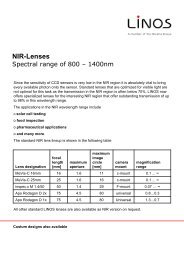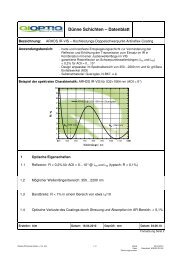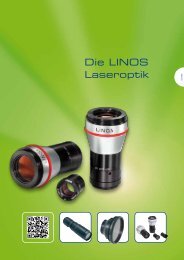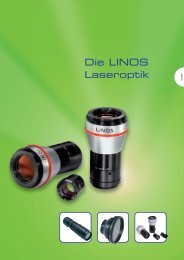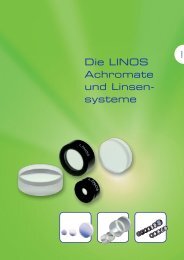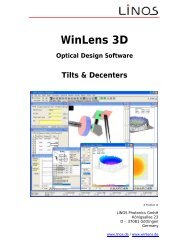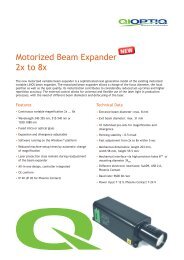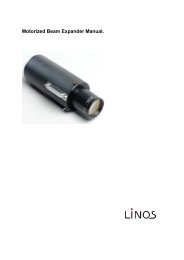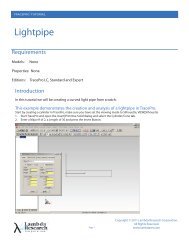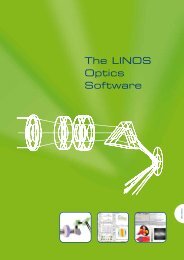The LINOS Laseroptics and Lenses - Qioptiq Q-Shop
The LINOS Laseroptics and Lenses - Qioptiq Q-Shop
The LINOS Laseroptics and Lenses - Qioptiq Q-Shop
- No tags were found...
You also want an ePaper? Increase the reach of your titles
YUMPU automatically turns print PDFs into web optimized ePapers that Google loves.
<strong>Laseroptics</strong> <strong>and</strong> <strong>Lenses</strong>Laser Beam Homogenizer, IntroductionMany applications, e.g. microscopy <strong>and</strong>material processing, require a very evendistribution of the illuminating light.Non-imaging HomogenizersImaging HomogenizersFor this purpose, microlens basedhomogenizers are available nowadaysfor numerous light sources, ranging fromexcimer lasers to high power LEDs.Two general types are distinguished,Non-Imaging <strong>and</strong> Imaging Homogenizers.Both types split the incident beaminto small sub beams. This is achieved bypassage either through arrays ofcylindrical lenses in a crossed configuration,or through arrays of microlenses. <strong>The</strong>sub beams are then superimposed by aspherical lens in its focal plane, leadingto a homogeneously illuminated field.This spherical lens is called Fourier lens,as it effectively performs a two dimensionalFourier transformation.Fig. 1 Fig. 2Non-Imaging Homogenizers are builtfrom one microlens array <strong>and</strong> onespherical lens (see fig. 1). <strong>The</strong> plane ofhomogenization lies in the focal plane ofthe Fourier lens (FL), the size of thehomogeneously illuminated area isdetermined by:Imaging Homogenizers are built fromtwo microlens arrays <strong>and</strong> one sphericallens (see fig. 2). <strong>The</strong> plane of homogenizationlies in the focal plane of theFourier lens (FL), the size of the homogenizedarea is defined by:with<strong>Laseroptics</strong><strong>The</strong> application itself should be consideredwhen choosing between Non-Imaging <strong>and</strong> Imaging Homogenizer. Asan orientation aid one should considerthe Fresnel number, which is defined formicrolens homogenizers by:where P LArepresents the pitch of themicrolens array, D FTthe size of the flattop in the plane of homogenization, f FLthe focal length of the Fourier lens, <strong>and</strong> lis the wavelength. <strong>The</strong> Fresnel number isthe most important determinant for laserbeam homogenizers based on microlensarrays. As a general rule, the uniformityof the flat top increases with higherFresnel numbersNon-Imaging Homogenizers often showdominant diffraction effects due toFresnel diffraction at the microlens array.In practice, Fresnel numbers of FN >10, orbetter FN >100, lead to homogeneousintensities. Due to the connection of theFresnel number with the size of the flattop, Non-Imaging Homogenizers are thefirst choice for illuminating large areas.For small Fresnel numbers of FN < 10, orwhen a very even distribution is required,Imaging Homogenizers should bechosen.Here, a 12denotes the distance betweenthe two microlens arrays. As withNon-Imaging Homogenizers, the incidentbeam is split into many small sub beamswith the first microlens array. <strong>The</strong> secondmicrolens array then acts, in combinationwith the spherical lens, like an array ofobjective lenses, overlapping the subbeams of the first array in the plane ofhomogenization. As the size of the flattop depends in this case on the distancebetween the two arrays, it can easily beadjusted by moving the second array.However, great care has to be taken thatthe second array is not moved into thefocus plane of the first array, where itcould be damaged by focussed highenergy laser light.Imaging Homogenizers usually use microlensarrays of identical pitch. <strong>The</strong> shapeof the flat top is determined by theshape of the microlenses (e.g. square,round, hexagonal).Germany-Phone: +49 (0) 551/ 6935-0 France-Phone: +33 - 47 25 20 420437



